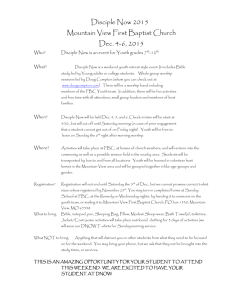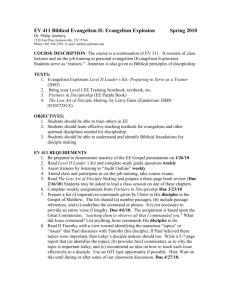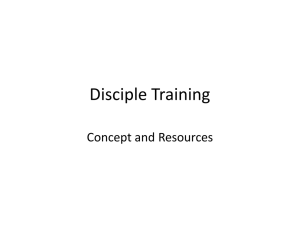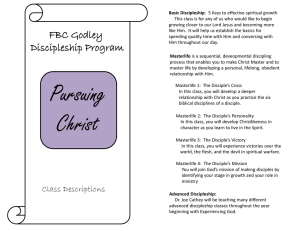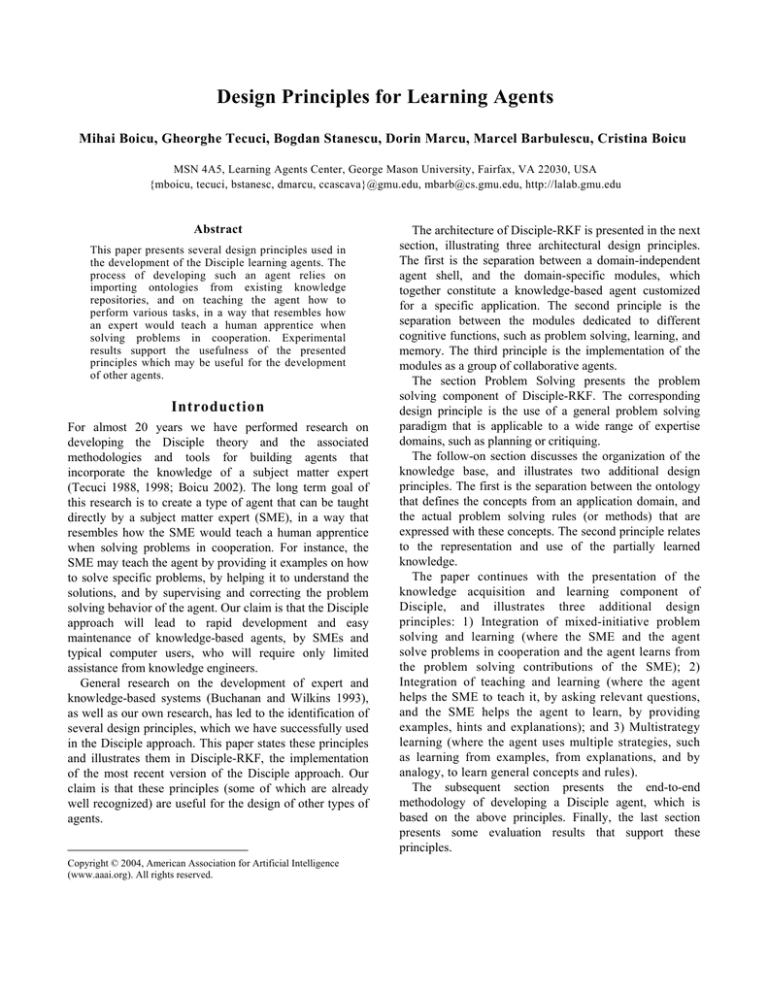
Design Principles for Learning Agents
Mihai Boicu, Gheorghe Tecuci, Bogdan Stanescu, Dorin Marcu, Marcel Barbulescu, Cristina Boicu
1
MSN 4A5, Learning Agents Center, George Mason University, Fairfax, VA 22030, USA
{mboicu, tecuci, bstanesc, dmarcu, ccascava}@gmu.edu, mbarb@cs.gmu.edu, http://lalab.gmu.edu
Abstract
This paper presents several design principles used in
the development of the Disciple learning agents. The
process of developing such an agent relies on
importing ontologies from existing knowledge
repositories, and on teaching the agent how to
perform various tasks, in a way that resembles how
an expert would teach a human apprentice when
solving problems in cooperation. Experimental
results support the usefulness of the presented
principles which may be useful for the development
of other agents.
Introduction
For almost 20 years we have performed research on
developing the Disciple theory and the associated
methodologies and tools for building agents that
incorporate the knowledge of a subject matter expert
(Tecuci 1988, 1998; Boicu 2002). The long term goal of
this research is to create a type of agent that can be taught
directly by a subject matter expert (SME), in a way that
resembles how the SME would teach a human apprentice
when solving problems in cooperation. For instance, the
SME may teach the agent by providing it examples on how
to solve specific problems, by helping it to understand the
solutions, and by supervising and correcting the problem
solving behavior of the agent. Our claim is that the Disciple
approach will lead to rapid development and easy
maintenance of knowledge-based agents, by SMEs and
typical computer users, who will require only limited
assistance from knowledge engineers.
General research on the development of expert and
knowledge-based systems (Buchanan and Wilkins 1993),
as well as our own research, has led to the identification of
several design principles, which we have successfully used
in the Disciple approach. This paper states these principles
and illustrates them in Disciple-RKF, the implementation
of the most recent version of the Disciple approach. Our
claim is that these principles (some of which are already
well recognized) are useful for the design of other types of
agents.
Copyright © 2004, American Association for Artificial Intelligence
(www.aaai.org). All rights reserved.
The architecture of Disciple-RKF is presented in the next
section, illustrating three architectural design principles.
The first is the separation between a domain-independent
agent shell, and the domain-specific modules, which
together constitute a knowledge-based agent customized
for a specific application. The second principle is the
separation between the modules dedicated to different
cognitive functions, such as problem solving, learning, and
memory. The third principle is the implementation of the
modules as a group of collaborative agents.
The section Problem Solving presents the problem
solving component of Disciple-RKF. The corresponding
design principle is the use of a general problem solving
paradigm that is applicable to a wide range of expertise
domains, such as planning or critiquing.
The follow-on section discusses the organization of the
knowledge base, and illustrates two additional design
principles. The first is the separation between the ontology
that defines the concepts from an application domain, and
the actual problem solving rules (or methods) that are
expressed with these concepts. The second principle relates
to the representation and use of the partially learned
knowledge.
The paper continues with the presentation of the
knowledge acquisition and learning component of
Disciple, and illustrates three additional design
principles: 1) Integration of mixed-initiative problem
solving and learning (where the SME and the agent
solve problems in cooperation and the agent learns from
the problem solving contributions of the SME); 2)
Integration of teaching and learning (where the agent
helps the SME to teach it, by asking relevant questions,
and the SME helps the agent to learn, by providing
examples, hints and explanations); and 3) Multistrategy
learning (where the agent uses multiple strategies, such
as learning from examples, from explanations, and by
analogy, to learn general concepts and rules).
The subsequent section presents the end-to-end
methodology of developing a Disciple agent, which is
based on the above principles. Finally, the last section
presents some evaluation results that support these
principles.
The Architecture of a Disciple Agent
The existing agent-building tools trade power (i.e., the
assistance given to the developer) against generality
(i.e., their domain of applicability), covering a large
spectrum. At the power end of the spectrum are the tools
customized for a problem-solving method and a
particular domain, such as SALT with its propose-andrevise method for design (Marcus and McDermott
1989). At the generality end are the tools applicable to a
wide range of tasks and domains, such as SOAR (Jones
et al. 1999) and CLIPS (Giarratano and Riley 1994). In
between are the tools that are method-specific and
domain independent (Chandrasekaran and Johnson
1993).
The first architectural design principle attempts to
find the best trade-off between generality and power,
and is illustrated by the Disciple agent architecture
presented in Figure 1.
Design principle 1 (generality-power tradeoff):
Structure the architecture of the agent building tool into
a reusable domain-independent learning agent shell
(which ensures the generality of the tool) and domainspecific modules (which need to be built for a specific
agent, to ensure the efficiency and domain-adaptability
of the tool).
Disciple-RKF is a learning agent shell (Tecuci, 1998).
Its main components, presented in the left hand side of
Figure 1, are:
• A problem solving component based on task reduction. It
includes a modeling agent that helps the user to express
his/her contributions to the problem solving process, a
mixed-initiative (step-by-step) problem solving agent,
and an autonomous problem solving agent.
• A learning component for acquiring and refining the
knowledge of the agent, allowing a wide range of
Disciple Agent
Learning Agent Shell
Graphical User
Interface
Knowledge
Repository
Knowledge
Acquisition
and Learning
Customized
User Interface
operations, from ontology import and user definition of
knowledge base elements (through the use of editors and
browsers), to ontology learning and rule learning.
• A knowledge base manager which controls the access
and the updates to the knowledge base. Each module of
Disciple can access the knowledge base only through the
functions of the knowledge base manager.
• A window-based, domain-independent, graphical user
interface.
The three components in the right hand side of Figure 1
are the typical domain dependent components of a
Disciple agent that was customized for a specific
application:
• A customized problem solving component that
extends the basic task-reduction component in order to
satisfy the specific problem solving requirements of
the application domain.
• Customized graphical user interfaces which are built
for the specific Disciple agent to allow the SMEs and
the end users to communicate with the agent as close
to the way they are used to communicate as possible.
• The knowledge base of the Disciple agent.
The next design principle illustrated by the
architecture of a Disciple agent is well-represented in
several cognitive architectures:
Design principle 2 (cognitive functions separation):
Structure the architecture of the agent into separate
modules, each dedicated to a different cognitive
function, such as communication, problem solving,
learning, and memory.
Finally, the third architectural principle illustrated by
Disciple-RKF is:
Design principle 3 (cognitive module as collaborative
agent): Implement each cognitive module as a
collaborative agent, in a mixed-initiative framework.
A discussion of mixed-initiative reasoning in Disciple
is provided in (Tecuci et al. 2003; Boicu et al. 2003).
The next sections discuss additional design principles
that are illustrated by the individual modules of
Disciple-RKF.
Problem Solving
Problem
Solver
Customized
Problem Solver
Knowledge
Base Manager
Knowledge Base
Domain Independent Modules
Domain Dependent
Modules
Figure 1: General architecture of a Disciple agent.
Design principle 4 (general problem solving
paradigm): Base the problem solver of the learning
agent on a general problem solving paradigm (such as
task reduction, state-space search, or case-based
reasoning), that can be applied to a wide range of
application domains, but develop a modeling framework
specialized for that paradigm, to help the SMEs express
their reasoning process and teach the agent.
The concept of a learning agent shell (illustrated by
T0
T0
S0
S0
Disciple-RKF), with its domain-independent problem
Q0
solving and learning components (see Figure 1), is an
A0
extension of the concept of expert system shell (Clancey
T1
T1
S1
S1
1984). An expert system shell consists of a general
inference engine for a given expertise domain (such as
Q1
diagnosis, design, planning, scheduling, monitoring, or
A1
interpretation), and a representation formalism for encoding
T11
T11
S11
S11
the knowledge base for a particular application in that
Q11
domain. The idea of the expert system shell emerged from
A11a
S11a
the architectural separation between the general inference
…
…
engine and the application-specific knowledge base, with
…
…
…
…
A11m
S11m
the goal of reusing the inference engine for a new system.
The problem solving component of the Disciple learning
T1n S1n
T1n S1n
agent shell is based on the task reduction paradigm, and is
more general than even the inference engine of an expert
Figure 2: Question-answering based task reduction.
system shell. The principle of the task reduction paradigm
• A planning agent, for determining how a convoy of
is that a complex problem solving task (e.g. T0 in Figure 2)
military vehicles can circumvent or overcome
is successively reduced to simpler tasks, then the solutions
obstacles in their path, such as damaged bridges
of the simplest tasks are found (e.g. S11, … , S1n) and these
(Tecuci et al., 1999).
solutions are successively combined into the solution of the
initial task (e.g. S0), as illustrated in the left hand side of
• A critiquing agent, for identifying strengths and
Figure 2 (Nilsson 1971; Powell and Schmidt 1988).
weaknesses in a military course of action, based on the
In the Disciple approach we have refined this general
principles of war and the tenets of Army operation
strategy to serve both as a problem solving method for the
(Tecuci et al., 2001).
agent and as a modeling language for the SME (Bowman
• An analysis agent, for identification and testing of
2002). We did this by introducing questions and answers
strategic center of gravity candidates in military
that guide the task reduction process, as illustrated in the
conflicts (Tecuci et al., 2002b).
right hand side of Figure 2. Finding a solution of a problem
solving task (T0) becomes an iterative process where, at
each step, the expert (and/or the agent) looks for some
relevant information by asking a question Q. The
answer A identifies that piece of information and
leads to the reduction of the current task to I need to
Determine a COG candidate for Sicily_1943
simpler tasks. Alternative questions correspond to
alternative problem solving strategies. Several Which is an opposing_force in the Sicily_1943 scenario?
answers (e.g. A11a or A11m) correspond to several
Allied_Forces_1943
solutions.
Therefore I need to
Determine a COG candidate for Allied_Forces_1943
Figures 3 illustrate this process with an
example from the center of gravity analysis
Is Allied_Forces_1943 a single_member_force or a multi_member_force?
domain. In this example, the SME shows the
Allied_Forces_1943 is a multi_member_force
agent how to reason to determine the centers of
Therefore I need to
gravity of the opposing forces from World War
Determine a COG candidate for Allied_Forces_1943 which is a multi_member_force
II, at the time of the invasion of the island of
What type of strategic COG candidate should I consider for this multi_member_force?
Sicily.
I consider a candidate corresponding to a member of the multi_member_force
Our claim is that this formulation of the task
Therefore I need to
reduction paradigm is appropriate for naturally
Determine a COG candidate corresponding to a member
modeling a wide range of expertise domains.
of the Allied_Forces_1943
This claim is supported by the development of
Which is a member of Allied_Forces_1943?
the following complex Disciple agents, as part
US_1943
of the DARPA’s High Performance Knowledge
Therefore I need to
Bases (1997-2000), and Rapid Knowledge
Determine a COG candidate for US_1943
Formation (2000-2004) programs (Tecuci and
Boicu 2002a):
Figure 3: An illustration of task reduction.
Knowledge Base = Ontology + Rules
Design principle 5 (knowledge base structuring):
Structure the knowledge base into its more general and
reusable component (the object ontology), and its more
specific component (the reasoning methods or rules).
The object ontology is a hierarchical representation of
the objects and types of objects from a particular
domain, such as military or medicine. That is, it
represents the different kinds of objects, the properties
of each object, and the relationships between objects.
Figure 4, for instance, presents a fragment of the
Disciple ontology for the center of gravity analysis
domain (Stanescu et al., 2003).
The object ontology provides a representation
vocabulary for the reduction and composition rules.
Each reduction rule is an IF-THEN structure that
expresses the conditions under which a task T1 can be
reduced to the simpler tasks T11, … , T1n. Similarly, a
composition rule is an IF-THEN structure that expresses
the conditions under which the solutions S11, … , S1n of
the tasks T11, … , T1n can be combined into a solution S1
of T1 (see Figure 2). The bottom part of Figure 6 shows
the informal and the formal structures of a task reduction
rule.
This organization of the knowledge base is very
important because it clearly separates the most general
part of it (the object ontology), from its most specific
part (the rules). Indeed, an object ontology is
characteristic to an entire domain. In the military
domain, for instance, the object ontology will include
descriptions of military forces. These descriptions are
most likely needed in almost any specific military
application. Because building the object ontology is a
very complex process, it makes sense to reuse these
descriptions when developing a knowledge base for
another military application, rather than starting from
scratch. This justifies why the Disciple learning agent
shell includes modules for ontology import and ontology
force
multi_member_force
multi_group_force
single_member_force
multi_state_force
single_group_force
...
single_state_force
...
multi_state_alliance
Universe of
Instances
Eh
Plausible
Upper Bound
multi_state_coalition
...
dominant_partner_
multi_state_alliance
merging (Barbulescu et al. 2003).
The rules from the knowledge base are much more
specific than the object ontology. Consider, for instance,
two agents in the military domain, one that critiques
courses of action with respect to the principles of war
(Tecuci et al., 2001), and another that analyzes the
center of gravity candidates of a force (Tecuci et al.,
2002). While both agents need to reason with military
forces, their reasoning rules are very different, being
specific not only to their particular application (course
of action critiquing vs. center of gravity analysis), but
also to the SMEs whose expertise they encode.
Design principle 6 (partially learned knowledge):
Design the agent to allow the representation, use, and
continuous refinement of partially learned knowledge.
The Disciple agents have the capability of
incrementally learning reasoning rules from the SMEs,
as will be discussed in the next section. This capability,
in turn, requires the capability of representing and
reasoning with incompletely learned knowledge pieces.
At the basis of Disciple’s learnable representation of
knowledge are the notion of plausible version space
(Tecuci 1998) and the use of the object ontology as an
incomplete generalization hierarchy for learning. A
plausible version space is an approximate representation
for a partially learned concept, as illustrated in Figure 5.
The partially learned concept is represented by a
plausible upper bound concept which, as an
approximation, is more general than the concept Eh to be
learned, and by a plausible lower bound concept which,
again as an approximation, is less general than Eh.
During learning, the two bounds (which are first order
logical expressions) converge toward one another
through successive generalizations and specializations,
approximating Eh better and better. Notice, however,
that these generalization and specialization operations
are based on an ontology that is itself evolving during
knowledge acquisition and learning (for instance, by
adding new concepts in the hierarchy from Figure 4).
Therefore Disciple addresses the complex problem of
learning in the context of an evolving representation
language. All the knowledge pieces from the agent’s
knowledge base (objects, tasks, and rules) are
Plausible
Lower Bound
equal_partners_
multi_state_alliance
Allied_Forces_1943
has_as_member
US_1943
Figure 4: Ontology fragment for COG analysis.
Figure 5: A representation of a plausible version space.
represented using plausible version spaces, and may be
learned by the agent from specific examples provided by
the SME. For instance, the rule from the bottom of
Figure 6 was learned from the example shown at the top
of Figure 6, and the explanation of this example. Notice
the plausible version space condition of the formal
structure of the rule, represented by a plausible upper
bound condition and a plausible lower bound condition.
Learning
The main strength of a Disciple agent is its ability to learn
from an SME. This capability is based on three design
principles that will be briefly described in the following.
Design principle 7 (integrated problem solving and
learning): Design the agent to support integrated
problem solving and learning, where the SME and the
agent solve problems in cooperation and the agent
learns from the problem solving contributions of the
SME, and from its own problem solving attempts.
This form of situated learning during problem solving
facilitates the definition of examples by the SME, and the
learning and refinement of the rules by the agent.
Initially, the interaction between the SME and a
Disciple agent has the flavor of a teacher-student
interaction, where the SME shows the agent each
problem solving step required to solve a task, and the
agent learns a general task reduction rule from each step.
For instance, the rule from the bottom of Figure 6 was
learned from the SME-provided example shown at the
top of Figure 6 (which was actually provided as the
bottom step from the problem solving tree in Figure 3).
As Disciple learns new rules from the SME, the
interaction between the SME and Disciple evolves from a
teacher-student interaction, toward an interaction where
both collaborate in solving a problem. During this mixedinitiative problem solving phase, Disciple learns not only
from the contributions of the SME, but also from its own
successful or unsuccessful problem solving attempts, which
lead to the refinement of the rule’s plausible version space
condition (Boicu et al., 2000).
Design principle 8 (integrated teaching and learning):
Design the agent to support integrated teaching and
learning, where the agent helps the SME to teach it (e.g.
by asking relevant questions), and the SME helps the
agent to learn (e.g. by providing examples, hints and
explanations).
Let us consider, for instance, the example from the top
of Figure 6, which was provided by the SME. The SME
helps the agent to understand that the meaning of the
Question–Answer pair from this example is
“Allied_Forces_1943 has_as_member US_1943”, and
that this is the reason of performing the reduction
represented by this example. As a consequence, Disciple
automatically generates the plausible version space rule
from the bottom of Figure 6, where the plausible lower
bound condition is the minimal generalization of the
above explanation piece and the other objects from the
example, and the plausible upper bound is the maximal
generalization. Both these generalizations are based on
the agent’s ontology, a fragment of which is shown in
Figure 4. The middle part of Figure 6 shows also the
informal structure of the learned rule. This informal
structure preserves the natural language of the SME and
is used in agent-user communication. The formal
structure from the bottom part of Figure 6 is used in the
actual reasoning of the agent.
Design principle 9 (multistrategy learning): Design the
learning module of the agent as a multistrategy learner that
synergistically integrates several learning strategies,
taking advantage of their complementary strengths to
compensate for each other’s weaknesses (Michalski and
Tecuci, 1994).
For instance, Figure 7 represents the rule refinement
method of Disciple that integrates learning by analogy and
experimentation, learning from examples, and learning
EXAMPLE OF TASK REDUCTION STEP
I need to
Determine a COG candidate corresponding to a
member of the Allied_Forces_1943
Which is a member of Allied_Forces_1943?
US_1943
Therefore
I need to
Determine a COG candidate for US_1943
INFORMAL STRUCTURE OF THE RULE
IF
Determine a COG candidate corresponding to a
member of the ?O1
Question: Which is a member of ?O1 ?
Answer: ?O2
THEN
Determine a COG candidate for ?O2
FORMAL STRUCTURE OF THE RULE
IF
Determine a COG candidate corresponding to a
member of a force
The force is ?O1
Plausible Upper Bound Condition
?O1 is
multi_member_force
has_as_member ?O2
?O2 is
force
Plausible Lower Bound Condition
?O1 is
equal_partners_multi_state_alliance
has_as_member ?O2
?O2 is
single_state_force
THEN:
Determine a COG candidate for a force
The force is ?O2
Figure 6: An example and the rule learned from it.
Knowledge Base
Learning by Analogy
and Experimentation
PVS
rule
Failure
explanation
Example of task reductions
generated by the agent
Incorrect
example
Correct
example
Learning from
Explanations Learning from Examples
Figure 7: The rule refinement method of Disciple.
from explanations. The plausible upper bound condition of
a learned rule allows it to apply to situations that are
analogous with the one from which the rule was learned. If
the SME judges this application as correct, then this
represents a new positive example of the rule, and the
plausible lower bound condition is generalized to cover it.
Otherwise, the agent will interact with the SME to find an
explanation of why the application is incorrect, and will
specialize the rule’s conditions appropriately. Rule
refinement could lead to a complex task reduction rule,
with additional except-when conditions which should not
be satisfied in order for the rule to be applicable (Boicu et
al. 2000).
reduction (5). During task learning (6) the SME and
Disciple collaborate in formalizing the tasks from the
SME’s examples, and Disciple learns general task
patterns. Then the SME helps Disciple to understand
each task reduction step and Disciple learns general task
reduction rules (7). Disciple uses the partially learned
rules in problem solving and then refines them based on
SME’s feedback (8). At the same time, Disciple extends
the object ontology with new objects and features (9).
During problem solving (10) Disciple automatically
solves problems, providing solutions and detailed
justifications.
While the above is the normal sequence of these steps,
there is also the need to return to a previous step. For
instance, while performing the step-by-step problem
solving and rule refinement, the SME may need to
define a new reduction which requires him/her to
perform modeling, task learning and rule learning.
It is possible for copies of Disciple agents to be
trained in parallel by different SMEs. In this case the
individual knowledge bases have to be merged into an
integrated knowledge base (11). The resulting
knowledge base can also be exported for use in the
development of new agents (12). The last phase
represents the use of the developed Disciple agent by the
intended end-users (13).
Evaluation
Agent Development Methodology
As indicated in Figure 8, the Disciple approach covers
all the phases of agent development and use. First, the
knowledge engineer works with the SME to develop an
initial model of how the SME solves problems, based on
the task reduction paradigm (1). The model identifies
also the object concepts that need to be present in
Disciple’s ontology so that it can perform this type of
reasoning. These object concepts represent a
specification of the needed ontology, specification that
guides the process of importing ontological knowledge
from existing knowledge repositories (2). The
knowledge engineer and the SME extend the imported
ontology and define the scripts for scenario elicitation
(3).
The result of these initial knowledge base
development steps is a complete enough object ontology
that will allow a SME to train the Disciple agent how to
solve problems, with limited assistance from a
knowledge engineer. First, during scenario elicitation
(4), Disciple guides the SME to describe a scenario and
then creates a formal description of it consisting of
instances in the object ontology. Then, using the initial
domain model as a guide, the SME expresses in English
how he or she solves specific problems through task
Over the last four years, several experiments have been
performed at the US Army War College, with
increasingly more capable versions of Disciple.
During three successive sessions of the “589jw
Military Applications of Artificial Intelligence” course
(held in Spring 2001, Spring 2002, and Spring 2003,
respectively), a total of 38 US and international officers
from all branches of the military have trained personal
Disciple agents, with limited assistance from knowledge
engineers. At the end of each experiment, we have asked
the military experts to express their disagreement or
agreement with the following statement: “I think that a
subject matter expert can use Disciple to build an agent,
with limited assistance from a knowledge engineer.”
Out of the 38 experts, 10 strongly agreed with the
above statement, 20 of them agreed, 7 were neutral, and
1 disagreed, which represents a very encouraging result.
Successive versions of trained Disciple agents were
also used in 8 sessions of the “319jw Case Studies in
COG Analysis” course (the COG course), by a total of
71 military students. In the COG courses, the students
have used Disciple as an intelligent assistant that helped
them to develop a Center of Gravity analysis of a war
scenario. For instance, all the 8 students from the Spring
2003 session of the COG course have agreed or strongly
Rule Learning
Task Learning
Rule Refining
Modeling the Problem
Solving Process
Ontology Learning
KNOWLEDGE ELICITATION
AND MODELING
LEARNING AND
PROBLEM SOLVING
Scenario Elicitation
Problem Solving
Disciple
RKF
KNOWLEDGE
BASE
Ontology Development
INITIAL MODELING AND
ONTOLOGY DEVELOPMENT
Ontology Import
Initial Modeling and
Ontology Specification
KNOWLEDGE BASE
INTEGRATION,
EXPORT, AND USE
Knowledge Bases
Integration
Knowledge Base Export
Use of Disciple Agent
Figure 8: The phases of agent development and use.
agreed with the following statements: “The use of
Disciple is an assignment that is well suited to the
course's learning objectives” and “Disciple should be
used in future versions of this course”.
The significance of this result is that it shows that the
Disciple approach can be used to build practical agents
for complex real-world problems.
More evaluation results are presented in (Tecuci et al.,
2001; Tecuci et al., 2002).
While several of the design principles discussed in
this paper are not unique to Disciple, what is unique is
the integrated application of all of them within a single
agent architecture, which proved to be very successful,
as suggested by the above evaluation results.
Acknowledgments
This research was sponsored by DARPA, AFRL,
AFMC, USAF, under agreement number F30602-00-20546, by the AFOSR under grant no. F49620-00-1-0072,
and by the US Army War College. Several persons
supported this effort, including David Gunning, Murray
Burke, William Rzepka, Jerome Comello, William
Cleckner, Douglass Campbell, David Brooks, David
Cammons, and Michael Bowman.
References
Barbulescu, M., Balan, G., Boicu, M., Tecuci, G. 2003. Rapid
development of large knowledge bases. In Proceedings of the
IEEE International Conference on Systems, Man and
Cybernetics, 3: 2169-2174, Institute of Electrical and
Electronics Engineers, Inc.
Boicu, M. 2002. Modeling and Learning with Incomplete
Knowledge, Ph.D. diss., Dept. of Computer Science, George
Mason Univ.
Boicu M., Tecuci G., Marcu D., Bowman M., Shyr P., Ciucu
F., and Levcovici C. 2000. Disciple-COA: From Agent
Programming to Agent Teaching. In Proceedings of the
Seventeenth International Conference on Machine Learning,
Stanford, CA: Morgan Kaufmann.
Boicu M., Tecuci G., Marcu D., Boicu C., and Stanescu B.
2003. Mixed-Initiative Control for Teaching and Learning in
Disciple. In Proceedings of IJCAI-2003 Workshop on MixedInitiative Intelligent Systems, 9-16, Menlo Park, CA: AAAI
Press.
Bowman, M. 2002. A Methodology for Modeling Expert
Knowledge that Supports Teaching Based Development of
Agents. Ph.D. diss., Dept. of Computer Science, George
Mason Univ.
Buchanan, B.G. and Wilkins, D.C. eds. 1993. Readings in
Knowledge Acquisition and Learning: Automating the
Construction and Improvement of Expert Systems. San
Francisco, CA: Morgan Kaufmann.
Chandrasekaran, B., and Johnson, T. R. 1993. Generic Tasks
and Task Structures: History, Critique and New Directions. In
David, J.M., Krivine, J.P., and Simmons, R. eds. Second
Generation Expert Systems, 239-280, Springer-Verlag.
Clancey, W. J. 1984. NEOMYCIN: Reconfiguring a rulebased system with application to teaching. In Clancey W. J.
and Shortliffe, E. H., eds. Readings in Medical Artificial
Intelligence, 361-381. Reading, MA: Addison-Wesley.
Giarratano, J., and Riley, G. 1994. Expert Systems: Principles
and Programming, Boston, MA: PWS Publishing Comp.
Jones, R. M., Laird, J. E., Nielsen P. E., Coulter, K., Kenny,
P., and Koss, F. 1999. Automated Intelligent Pilots for Combat
Flight Simulation, AI Magazine 20(1): 27-42.
Tecuci, G. 1998. Building Intelligent Agents: An
Apprenticeship Multistrategy Learning Theory, Methodology,
Tool and Case Studies. London: Academic Press.
Marcus S. and McDermott J. 1989. SALT: A Knowledge
Acquisition Language for Propose-and-Revise Systems,
Artificial Intelligence 39: 1-37.
Tecuci, G., Boicu, M., Wright, K., Lee, S.W., Marcu, D., and
Bowman, M. 1999. An integrated shell and methodology for
rapid development of knowledge-based agents. Proc.
AAAI/IAAI, pp. 250-257, AAAI Press, Menlo Park CA.
Michalski, R. S. and Tecuci, G., eds. 1994. Machine Learning:
A Multistrategy Approach Volume 4. San Mateo, CA.: Morgan
Kaufmann.
Nilsson, N.J. 1971. Problem Solving Methods in Artificial
Intelligence. New York, NY: McGraw-Hill.
Powell G.M. and Schmidt C.F. 1988. A First-order
Computational Model of Human Operational Planning,
CECOM-TR-01-8, US Army CECOM, Fort Monmouth, New
Jersey.
Stanescu B., Boicu C., Balan G., Barbulescu M., Boicu M.,
Tecuci G. 2003. Ontologies for Learning Agents: Problems,
Solutions and Directions. In Proceedings of the IJCAI-03
Workshop on Workshop on Ontologies and Distributed
Systems, 75-82. Acapulco, Mexico, AAAI Press, Menlo Park,
CA.
Tecuci G. 1988. DISCIPLE: A Theory, Methodology and
System for Learning Expert Knowledge, Thèse de Docteur en
Science, University of Paris-South.
Tecuci G., Boicu M., Bowman M., and Marcu D., with a
commentary by Burke M. 2001. An Innovative Application
from the DARPA Knowledge Bases Programs: Rapid
Development of a High Performance Knowledge Base for
Course of Action Critiquing, AI Magazine, Vol. 22, No. 2, pp.
43-61.
Tecuci G., Boicu M. 2002a. Military Applications of the
Disciple Learning Agent. In Jain L, ed., Advanced Information
Systems in Defense and Related Applications, 337-376.
Springer Verlag.
Tecuci G., Boicu, M., Marcu, D., Stanescu, B., Boicu, C., and
Comello, J. 2002b. Training and Using Disciple Agents: A
Case Study in the Military Center of Gravity Analysis
Domain. AI Magazine 23(4): 51–68.
Tecuci G., Boicu M., Marcu D. 2003. Toward a Disciple-based
Mixed-Initiative Cognitive Assistant. In Proceedings of IJCAI2003 Workshop on Mixed-Initiative Intelligent Systems, 131137. Menlo Park, CA: AAAI Press.



